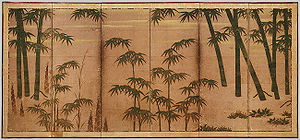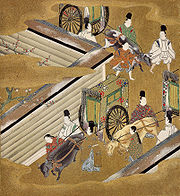
Tosa school
Encyclopedia

Japan
Japan is an island nation in East Asia. Located in the Pacific Ocean, it lies to the east of the Sea of Japan, China, North Korea, South Korea and Russia, stretching from the Sea of Okhotsk in the north to the East China Sea and Taiwan in the south...
ese painting was founded in the 15th century, and was devoted to yamato-e
Yamato-e
Yamato-e is a style of Japanese painting inspired by Tang Dynasty paintings and developed in the late Heian period. It is considered the classical Japanese style...
, which are paintings specializing in subject matter and techniques derived from ancient Japanese art
Japanese art
Japanese art covers a wide range of art styles and media, including ancient pottery, sculpture in wood and bronze, ink painting on silk and paper and more recently manga, cartoon, along with a myriad of other types of works of art...
, as opposed to schools influenced by Chinese art
Chinese art
Chinese art is visual art that, whether ancient or modern, originated in or is practiced in China or by Chinese artists or performers. Early so-called "stone age art" dates back to 10,000 BC, mostly consisting of simple pottery and sculptures. This early period was followed by a series of art...
.
The origins of this school of painting can be traced to Tosa Yukihiro (土佐 行弘), who first used the professional name of Tosa in the early fifteenth century. Later, the school was formally founded by Mitsunobu (1434?–?1525), and he served as official painter at the imperial court, specializing in courtly subjects painted in the yamato-e (やまと絵) style.
During this time, members of the Tosa school almost continuously held the position of head of the Imperial painting bureau (絵所預 edokoro-azukari). Until the 17th century, the Tosa school painted for the court and aristocratic patrons, which favored such painting subjects as scenes from the classic Tale of Genji (源氏絵), but in later years, the school's range expanded to include bird-and-flower painting
Bird-and-flower painting
Bird-and-flower painting is a kind of Chinese painting named after its subject matter. Normally, most bird-and-flower paintings belong to the scholar-artist style of Chinese painting....
and other Chinese-inspired themes and styles. In general, the Tosa style is characterized by rather flat, decorative compositions, fine linework, great attention to detail, and brilliant color.
History
The earliest documentary evidence for an artist using the name Tosa are two early 15th century references to a man named Fujiwara Yukihiro (藤原 行広) (fl.Floruit
Floruit , abbreviated fl. , is a Latin verb meaning "flourished", denoting the period of time during which something was active...
1406–1434) who was also known as Tosa Shōgen (土佐 将監), a title derived from his position as governor of Tosa Province
Tosa Province
is the name of a former province of Japan in the area that is today Kōchi Prefecture on Shikoku. Tosa was bordered by Iyo and Awa Provinces. It was sometimes called .-History:The ancient capital was near modern Nankoku...
. Yukihiro's activity as a painter is known primarily from an inscription on illustrated handscrolls of the Stories of the Origin of Yūzū Nembutsu (融通念仏縁起); 1414, Seiryōji (清涼寺), Kyoto.

Many fine works remain from Mitsunobu's hand. Although he painted both Buddhist painting
Buddhist art
Buddhist art originated on the Indian subcontinent following the historical life of Siddhartha Gautama, 6th to 5th century BC, and thereafter evolved by contact with other cultures as it spread throughout Asia and the world....
s and portraits in addition to the standard repertoire of courtly themes, he is best known for his illustrated handscrolls, emaki (絵巻), such as The Legends of Kiyomizu-dera
Kiyomizu-dera
, officially is an independent Buddhist temple in eastern Kyoto. The temple is part of the Historic Monuments of Ancient Kyoto UNESCO World Heritage site...
(清水寺縁起). During Mitsunobu's lifetime, the Tosa school may have had some influence on the early development of the Kanō school
Kano school
The ' is one of the most famous schools of Japanese painting. The Kanō school of painting was the dominant style of painting until the Meiji period.It was founded by Kanō Masanobu , a contemporary of Sesshū and student of Shūbun...
(狩野派) of painting, in particular, on the use of brilliant colors and gold in combination with the Chinese inspired brushwork, and for various themes for which the Kanō school is known.
Mitsunobu was succeeded by his son, Mitsumochi (光茂) (1496 – ca.1559), under whom the fortunes of the school began to decline. When Mitsumoto (光元) (fl. 1530–1569), the next head of the painting bureau, was killed in battle in 1569, his post was given to a second son or perhaps a student of Mitsumochi, Tosa Mitsuyoshi (土佐 光吉) (1539–1613). Mitsuyoshi eventually left the capital and his post and settled in the city of Sakai
Sakai, Osaka
is a city in Osaka Prefecture, Japan. It has been one of the largest and most important seaports of Japan since the Medieval era.Following the February 2005 annexation of the town of Mihara, from Minamikawachi District, the city has grown further and is now the fourteenth most populous city in...
(堺), a port city near Osaka, where he sold paintings to the local townspeople. Mitsumochi also moved away from the traditional Tosa themes to specialize in bird-and-flower paintings. During this period, the stewardship of the imperial painting bureau passed from the Tosa school into the hands of Kanō school painters.
Mitsuyoshi's son, Mitsunori (光則) (1583–1638) continued to live and work in Sakai, painting for townsmen, until 1634, when he moved to the capital with his eldest son, Mitsuoki
Tosa Mitsuoki
was a Japanese painter.-Tosa Mitsuoki:Tosa Mitsuoki was the successor of the Tosa school after his father, Tosa Mitsunori . Mitsuoki brought the Tosa school to Kyoto after around 50 years in Sakai. When the school was settled in Sakai, Mitsunori painted for townsmen...
(光起) (1617–1691) and began painting ceremonial fans for the court. Twenty years later, in 1654, Mitsuoki was appointed head of the imperial painting bureau, thus restoring the fortunes of the Tosa family. Mitsuoki also rejuvenated the traditional Tosa style by introducing elements from Chinese painting. He is particularly noted for his elegant paintings of quail
Quail
Quail is a collective name for several genera of mid-sized birds generally considered in the order Galliformes. Old World quail are found in the family Phasianidae, while New World quail are found in the family Odontophoridae...
, as for example, the Chrysanthemum and Quail screens which he painted with the help of his son Mitsunari (光成) (1646–1710).
Mitsuoki's successors headed the Imperial painting bureau until the end of the Edo period, but their reliance on imitating the style of Mitsuoki, rather than developing new techniques or themes, led to the production of works that were increasingly static and conventional.
Tosa artists of note
- Tosa Yukihiro
- Tosa MitsunobuTosa Mitsunobuwas a Japanese painter, the founder of the Tosa school of Japanese painting. Born into a family that had traditionally served as painters to the Imperial court, he was head of the court painting bureau from 1493 to 1496. In 1518 he was appointed chief artist to the Ashikaga shogunates.- External...
- Tosa MitsuokiTosa Mitsuokiwas a Japanese painter.-Tosa Mitsuoki:Tosa Mitsuoki was the successor of the Tosa school after his father, Tosa Mitsunori . Mitsuoki brought the Tosa school to Kyoto after around 50 years in Sakai. When the school was settled in Sakai, Mitsunori painted for townsmen...
- Tosa Mitsumochi
- Tosa Mitsumoto
- Tosa Mitsuyoshi (1539–1613)
- Tosa Mitsunori
- Tosa Mitsuzane (1780~1852)
- Iwasa MatabeiIwasa Matabeiwas a Japanese artist who specialized in genre scenes of historical events and illustrations of classical Chinese and Japanese literature, as well as portraits. He was the son of Araki Murashige, a prominent daimyo of the Sengoku period. Matabei's work was noted for its distinctive figures, with...

